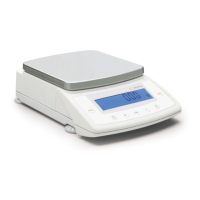Do you have a question about the Sartorius CPA6202S and is the answer not in the manual?
Read operating instructions carefully before use to prevent equipment damage.
Ensure correct voltage rating and use caution with RS-232 cables for safe installation.
Avoid extreme temperatures, moisture, shocks, blows, or vibration during storage and shipping.
Check equipment immediately for any external damage after unpacking.
Allow balance to acclimate to room temperature for about 2 hours after transfer to a warmer area.
EU legislation requires a control seal on accuracy class II balances; breaking it voids verification.
Instructions for assembling balance components and draft shield for CPA2P models.
Assembly steps for CPA2P-F models, including filter pans and standard weighing pans.
Procedure for positioning and securing the draft shield on balances with an analytical draft shield.
Steps to connect the CPA26P and CPA225D models to their respective electronics box.
Instructions for placing and securing the 3-sided draft shield on the balance.
How to place components on scales with rectangular pans and capacity up to 10 kg.
Procedure for placing the weighing pan on balances with rectangular pans and capacity over 10 kg.
Connect the AC adapter plug to the electronics box for CPA26P and CPA225D models.
Details on using country-specific power cords for the AC adapter.
Steps to connect the power cord to the AC adapter for balances with weighing capacities up to 10 kg.
Balance requires a specific warmup period after initial connection to AC power for accurate results.
How to secure balances with a weighing capacity up to 10 kg using a chain or lock.
To compensate for unevenness at the place of installation using leveling feet.
Adjusting the 2 front feet to level balances with capacities up to 10 kg.
Adjusting leveling feet to center the air bubble for balances with capacities over 10 kg.
Detailed explanation of the balance display indicators and operating keys.
Basic function for simple weighing or use with application programs.
Balance features include taring, assigning IDs, and printing weights.
Requirements for internal calibration/adjustment after warmup for legal metrology use.
Guidance for microbalance operation, emphasizing steady hand and temperature adjustment.
Understanding display indicators like the power disconnection symbol and its meaning.
Switching the balance off and its stand-by mode indication.
Specific instructions for filter weighing using the CPA2P-F microbalance with a filter pan.
Instructions for using the below-balance weighing port and hanger on analytical/precision balances.
Steps for attaching the below-balance weighing hook for CPA2P microbalances.
Defines calibration as determining differences and adjustment as correcting errors.
Requirements for internal calibration/adjustment after warmup for legal metrology use.
Conditions for calibration/adjustment and error messages.
External calibration/adjustment for accuracy class II balances is blocked by a seal.
Menu code and procedure for internal calibration using a motorized weight.
Configuring calibration to be followed by auto-adjustment or manual adjustment.
Permitted temperature ranges for verified balances in legal metrology applications.
Adapting the balance to individual requirements via Setup menu parameters and how to open the menu.
Procedures for printing current menu settings at different menu levels.
Configuring measurement environment parameters for ISO/GLP records and display adaptation.
Entering identification, date/time, and display brightness; describes key functions.
Step-by-step guide for setting the time, date, and display brightness on the balance.
Explains the F and CF keys for starting, toggling, and ending application programs.
Application programs can be selected on legal measuring instruments; calculated values use specific symbols.
Weighing different components up to a defined total component weight.
Identifies the menu code and display symbol for the Counting program.
Determining the number of parts based on a known reference sample quantity; minimum load and optional output.
Explains the F and CF keys for determining piece weight and ending the program.
Automatic updating to optimize counting accuracy; activation/deactivation in Setup menu.
Using a reference balance to determine reference weight for higher counting precision.
Identifies the menu code and display symbol for the Weighing in Percent program.
Obtaining weight readouts in percent relative to a reference weight; includes minimum load and reference percentage.
Explains F and CF keys for calculating percentage and changing reference percentage.
Setting parameters for the Weighing in Percent program in the Setup menu.
Examples of printout formats for Weighing in Percent results.
Identifies the menu code and display symbol for the Animal Weighing/Averaging program.
Determining weights of unstable samples by averaging operations; includes start modes and animal activity.
Keys for activating the program, changing subweighing operations, and storing settings.
Setting parameters for the Animal Weighing program in the Setup menu.
Example printout showing number of subweighing operations and calculated average.
Identifies the menu code for the Toggle Weight Units application and its configuration.
Pressing F to toggle between weight unit 1 and weight unit 2 for display.
Generating printouts with weights, values, and ID codes for documentation; covers types and formats.
Configuration options for printout types, line format, application parameters, ISO/GLP, and auto print.
Examples of printouts showing data with and without identification codes.
Generating printouts of configured initialization values for applications.
Having weight readouts printed automatically.
Parameters for ambient conditions printed before/after weighing series (GLP header/footer).
Menu codes for ISO/GLP compliant records, line format, and function keys.
Examples of lines included in ISO/GLP compliant printouts.
Specific printout examples for external calibration and adjustment procedures.
Balance interface for connecting to computers or peripheral devices; types and standards.
Default settings for transmission rate, parity, stop bits, handshake, and operating mode.
How non-verified digits are identified on printouts based on menu settings.
Details on 16-character and 22-character output formats, including special and error codes.
Defines two formats for sending control commands to the balance.
Lists command characters and their meanings for various balance functions.
Describes hardware handshake using CTS/DTR lines.
Explains software handshake control via XON/XOFF signals.
A detailed chart mapping interface connector pins to signal functions.
Caution about incorrect pin assignments in third-party RS-232 cables that can damage equipment.
Details of the female interface connector and specifications for the male connector.
Steps to prepare CPA2P models for transport, including removing parts and securing doors.
Instructions for preparing CPA2P-F models for transport, focusing on draft shield and filter pan.
Information on service contracts, repairs by technicians, and battery replacement cautions.
Procedures for unplugging, cleaning the balance with mild detergent, and drying.
Guidelines for cleaning stainless steel parts, including the weighing pan.
Instructions for cleaning the weighing chamber and draft shield, including removable parts.
Actions to take if safe operation is no longer warranted, including contacting service.
Guidance on proper disposal of packaging, equipment, and batteries according to EU legislation.
Technical specifications for CPA2P and CPA2P-F models, including weighing range, readability, and dimensions.
Accessories for data printing, statistics evaluation, transaction counting, and remote display.
External battery packs and carrying cases for balance protection and extended use.
Software for data transfer, density determination kit, and antistatic weighing pan.
Information on calibration weights and industrial AC adapters.
Draft shield covers, data cables, adapters, and remote control switches.
Weighing bowls of different capacities and materials, and dust covers for units.
Explains Council Directive 90/384/EEC regulating non-automatic weighing instruments for mass determination.
Services for optimal weighing instrument results and metrological verification by authorized technicians.
Information on verification validity and obtaining contact names for local regulations.
Official declaration stating compliance with European directives and standards.
Sartorius AG's declaration of compliance with EU directives and national laws for weighing instruments.
Illustrates plates and markings on various balance types and external electronics options.
Shows the location and locked/unlocked states of the menu access switch.
Defines the meaning of labels K, M, S, MD, T on the balance plates.
Shows an example of a plate with the model designation on the weighing instrument.
Displays an example of a descriptive plate on a weighing instrument that has already undergone verification.
| Max Capacity | 6200 g |
|---|---|
| Readability | 0.01 g |
| Display | LCD |
| Power Supply | AC adapter or battery |
| Repeatability (Standard Deviation) | 0.01 g |
| Linearity | ±0.02 g |
| Stabilization Time (typical) | 1.5 s |
| Interface | RS232 |











